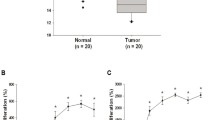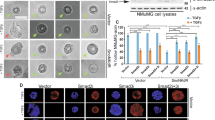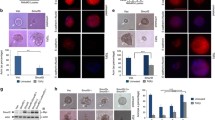Abstract
Transforming growth factor (TGF)-β regulates the expression of matrix metalloproteinases (MMPs) and components of the extracellular matrix, thereby profoundly affecting the microenvironment of cells including cancerous ones. We studied MMP-10 induction by TGF-β in mammary epithelial cells and found that the induction was dependent on the myocyte enhancer factor (MEF)-2 transcription factor. TGF-β upregulated the gene promoter through the MEF2 site, and knockdown of the MEF2A transcription factor negatively affected MMP-10 induction, whereas its overexpression had a positive effect on the induction. In response to TGF-β, acetylation and concomitant binding of MEF2A to the promoter region increased, thus suggesting a critical role of MEF2A in transactivation of MMP-10 by TGF-β. Consistent with the fact that class IIa histone deacetylases (HDACs) interact with MEF2 and suppress transcription, knockdown of HDACs increased and their overexpression inhibited MMP-10 expression. Intriguingly, TGF-β promoted proteasome-dependent degradation of HDACs. Consistent with this, acetylation of core histones was increased around the MEF2 site of the MMP-10 promoter by TGF-β and alleviated by overexpression of HDACs. Collectively, it is possible that TGF-β transcriptionally upregulated MMP-10 through activation of MEF2A, concomitant with acetylation of core histones increasing around the promoter, as a consequence of degradation of the class IIa HDACs.







Similar content being viewed by others

References
Angelelli C, Magli A, Ferrari D, Ganassi M, Matafora V, Parise F et al. (2008). Differentiation-dependent lysine 4 acetylation enhances MEF2C binding to DNA in skeletal muscle cells. Nucleic Acids Res 36: 915–928.
Aung PP, Oue N, Mitani Y, Nakayama H, Yoshida K, Noguchi T et al. (2006). Systematic search for gastric cancer-specific genes based on SAGE data: melanoma inhibitory activity and matrix metalloproteinase-10 are novel prognostic factors in patients with gastric cancer. Oncogene 25: 2546–2557.
Bierie B, Moses HL . (2006). Tumour microenvironment: TGFbeta: the molecular Jekyll and Hyde of cancer. Nat Rev Cancer 6: 506–520.
Chakraborti S, Mandal M, Das S, Mandal A, Chakraborti T . (2003). Regulation of matrix metalloproteinases: an overview. Mol Cell Biochem 253: 269–285.
Chang S, Young BD, Li S, Qi X, Richardson JA, Olson EN . (2006). Histone deacetylase 7 maintains vascular integrity by repressing matrix metalloproteinase 10. Cell 126: 321–334.
Cho NH, Hong KP, Hong SH, Kang S, Chung KY, Cho SH . (2004). MMP expression profiling in recurred stage IB lung cancer. Oncogene 23: 845–851.
Clark IM, Swingler TE, Sampieri CL, Edwards DR . (2008). The regulation of matrix metalloproteinases and their inhibitors. Int J Biochem Cell Biol 40: 1362–1378.
Derynck R, Akhurst RJ, Balmain A . (2001). TGF-beta signaling in tumor suppression and cancer progression. Nat Genet 29: 117–129.
Derynck R, Zhang Y, Feng XH . (1998). Smads: transcriptional activators of TGF-beta responses. Cell 95: 737–740.
Gill JH, Kirwan IG, Seargent JM, Martin SW, Tijani S, Anikin VA et al. (2004). MMP-10 is overexpressed, proteolytically active, and a potential target for therapeutic intervention in human lung carcinomas. Neoplasia 6: 777–785.
Impola U, Uitto VJ, Hietanen J, Hakkinen L, Zhang L, Larjava H et al. (2004). Differential expression of matrilysin-1 (MMP-7), 92 kD gelatinase (MMP-9), and metalloelastase (MMP-12) in oral verrucous and squamous cell cancer. J Pathol 202: 14–22.
Inoue Y, Imamura T . (2008). Regulation of TGF-beta family signaling by E3 ubiquitin ligases. Cancer Sci 99: 2107–2112.
Ishikawa F, Nose K, Shibanuma M . (2008). Downregulation of hepatocyte nuclear factor-4alpha and its role in regulation of gene expression by TGF-beta in mammary epithelial cells. Exp Cell Res 314: 2131–2140.
Izzi L, Attisano L . (2004). Regulation of the TGFbeta signalling pathway by ubiquitin-mediated degradation. Oncogene 23: 2071–2078.
Jakowlew SB . (2006). Transforming growth factor-beta in cancer and metastasis. Cancer Metastasis Rev 25: 435–457.
Kang JS, Alliston T, Delston R, Derynck R . (2005). Repression of Runx2 function by TGF-beta through recruitment of class II histone deacetylases by Smad3. EMBO J 24: 2543–2555.
Kanome T, Itoh N, Ishikawa F, Mori K, Kim-Kaneyama JR, Nose K et al. (2007). Characterization of Jumping translocation breakpoint (JTB) gene product isolated as a TGF-beta1-inducible clone involved in regulation of mitochondrial function, cell growth and cell death. Oncogene 26: 5991–6001.
Kato Y, Zhao M, Morikawa A, Sugiyama T, Chakravortty D, Koide N et al. (2000). Big mitogen-activated kinase regulates multiple members of the MEF2 protein family. J Biol Chem 275: 18534–18540.
Kerkela E, Ala-aho R, Lohi J, Grenman R, V MK, Saarialho-Kere U . (2001). Differential patterns of stromelysin-2 (MMP-10) and MT1-MMP (MMP-14) expression in epithelial skin cancers. Br J Cancer 84: 659–669.
Kitamura T, Koshino Y, Shibata F, Oki T, Nakajima H, Nosaka T et al. (2003). Retrovirus-mediated gene transfer and expression cloning: powerful tools in functional genomics. Exp Hematol 31: 1007–1014.
Lemercier C, Verdel A, Galloo B, Curtet S, Brocard MP, Khochbin S . (2000). mHDA1/HDAC5 histone deacetylase interacts with and represses MEF2A transcriptional activity. J Biol Chem 275: 15594–15599.
Levy L, Hill CS . (2005). Smad4 dependency defines two classes of transforming growth factor \{beta\} (TGF-\{beta\}) target genes and distinguishes TGF-\{beta\}-induced epithelial-mesenchymal transition from its antiproliferative and migratory responses. Mol Cell Biol 25: 8108–8125.
Liu D, Kang JS, Derynck R . (2004). TGF-beta-activated Smad3 represses MEF2-dependent transcription in myogenic differentiation. EMBO J 23: 1557–1566.
Ma K, Chan JK, Zhu G, Wu Z . (2005). Myocyte enhancer factor 2 acetylation by p300 enhances its DNA binding activity, transcriptional activity, and myogenic differentiation. Mol Cell Biol 25: 3575–3582.
Massague J, Gomis RR . (2006). The logic of TGFbeta signaling. FEBS Lett 580: 2811–2820.
Mathew R, Khanna R, Kumar R, Mathur M, Shukla NK, Ralhan R . (2002). Stromelysin-2 overexpression in human esophageal squamous cell carcinoma: potential clinical implications. Cancer Detect Prev 26: 222–228.
McKinsey TA, Zhang CL, Olson EN . (2002). MEF2: a calcium-dependent regulator of cell division, differentiation and death. Trends Biochem Sci 27: 40–47.
Miska EA, Karlsson C, Langley E, Nielsen SJ, Pines J, Kouzarides T . (1999). HDAC4 deacetylase associates with and represses the MEF2 transcription factor. EMBO J 18: 5099–5107.
Miyata Y, Iwata T, Maruta S, Kanda S, Nishikido M, Koga S et al. (2007). Expression of matrix metalloproteinase-10 in renal cell carcinoma and its prognostic role. Eur Urol 52: 791–797.
Mori K, Asakawa M, Hayashi M, Imura M, Ohki T, Hirao E et al. (2006). Oligomerizing potential of a focal adhesion LIM protein Hic-5 organizing a nuclear-cytoplasmic shuttling complex. J Biol Chem 281: 22048–22061.
Muraoka-Cook RS, Kurokawa H, Koh Y, Forbes JT, Roebuck LR, Barcellos-Hoff MH et al. (2004). Conditional overexpression of active transforming growth factor beta1 in vivo accelerates metastases of transgenic mammary tumors. Cancer Res 64: 9002–9011.
Nakamura H, Fujii Y, Ohuchi E, Yamamoto E, Okada Y . (1998). Activation of the precursor of human stromelysin 2 and its interactions with other matrix metalloproteinases. Eur J Biochem 253: 67–75.
Nelson JD, Denisenko O, Bomsztyk K . (2006). Protocol for the fast chromatin immunoprecipitation (ChIP) method. Nat Protoc 1: 179–185.
Ornatsky OI, Cox DM, Tangirala P, Andreucci JJ, Quinn ZA, Wrana JL et al. (1999). Post-translational control of the MEF2A transcriptional regulatory protein. Nucleic Acids Res 27: 2646–2654.
Pardali K, Moustakas A . (2007). Actions of TGF-beta as tumor suppressor and pro-metastatic factor in human cancer. Biochim Biophys Acta 1775: 21–62.
Piek E, Ju WJ, Heyer J, Escalante-Alcalde D, Stewart CL, Weinstein M et al. (2001). Functional characterization of transforming growth factor beta signaling in Smad2- and Smad3-deficient fibroblasts. J Biol Chem 276: 19945–19953.
Quinn ZA, Yang CC, Wrana JL, McDermott JC . (2001). Smad proteins function as co-modulators for MEF2 transcriptional regulatory proteins. Nucleic Acids Res 29: 732–742.
Ramos-DeSimone N, Hahn-Dantona E, Sipley J, Nagase H, French DL, Quigley JP . (1999). Activation of matrix metalloproteinase-9 (MMP-9) via a converging plasmin/stromelysin-1 cascade enhances tumor cell invasion. J Biol Chem 274: 13066–13076.
Shalizi A, Gaudilliere B, Yuan Z, Stegmuller J, Shirogane T, Ge Q et al. (2006). A calcium-regulated MEF2 sumoylation switch controls postsynaptic differentiation. Science 311: 1012–1017.
Sparrow DB, Miska EA, Langley E, Reynaud-Deonauth S, Kotecha S, Towers N et al. (1999). MEF-2 function is modified by a novel co-repressor, MITR. EMBO J 18: 5085–5098.
Thuault S, Valcourt U, Petersen M, Manfioletti G, Heldin CH, Moustakas A . (2006). Transforming growth factor-beta employs HMGA2 to elicit epithelial-mesenchymal transition. J Cell Biol 174: 175–183.
Weeks BH, He W, Olson KL, Wang XJ . (2001). Inducible expression of transforming growth factor beta1 in papillomas causes rapid metastasis. Cancer Res 61: 7435–7443.
Windsor LJ, Grenett H, Birkedal-Hansen B, Bodden MK, Engler JA, Birkedal-Hansen H . (1993). Cell type-specific regulation of SL-1 and SL-2 genes. Induction of the SL-2 gene but not the SL-1 gene by human keratinocytes in response to cytokines and phorbolesters. J Biol Chem 268: 17341–17347.
Yang SH, Galanis A, Sharrocks AD . (1999). Targeting of p38 mitogen-activated protein kinases to MEF2 transcription factors. Mol Cell Biol 19: 4028–4038.
Zhao M, New L, Kravchenko VV, Kato Y, Gram H, di Padova F et al. (1999). Regulation of the MEF2 family of transcription factors by p38. Mol Cell Biol 19: 21–30.
Acknowledgements
We thank Dr Eric N Olson (University of Texas Southwestern Medical School, Dallas, TX, USA) for his generous gift of the MMP-10 promoter luciferase constructs. We also thank Ms E Kaneko and Ms T Kaneko for contributing to this work as a project for their bachelor's degree. This work was supported in part by a Grant-in-Aid for Scientific Research (C) (19570185) and the High-Technology Research Center Project from the Ministry for Education, Culture Sports, Science and Technology (MEXT) of Japan, and also by the High-Tech Research Centre Project for Private Universities: a matching fund subsidy from MEXT, 2007–2009.
Author information
Authors and Affiliations
Corresponding author
Additional information
Supplementary Information accompanies the paper on the Oncogene website (http://www.nature.com/onc)
Rights and permissions
About this article
Cite this article
Ishikawa, F., Miyoshi, H., Nose, K. et al. Transcriptional induction of MMP-10 by TGF-β, mediated by activation of MEF2A and downregulation of class IIa HDACs. Oncogene 29, 909–919 (2010). https://doi.org/10.1038/onc.2009.387
Received:
Revised:
Accepted:
Published:
Issue Date:
DOI: https://doi.org/10.1038/onc.2009.387
- Springer Nature Limited
Keywords
This article is cited by
-
MEF2A transcriptionally upregulates the expression of ZEB2 and CTNNB1 in colorectal cancer to promote tumor progression
Oncogene (2021)
-
Matrix metalloproteinase-10: a novel biomarker for idiopathic pulmonary fibrosis
Respiratory Research (2015)
-
Loss of anchorage primarily induces non-apoptotic cell death in a human mammary epithelial cell line under atypical focal adhesion kinase signaling
Cell Death & Disease (2015)
-
Transforming growth factor-β1 induces matrix metalloproteinase-9 expression in rat vascular smooth muscle cells via ROS-dependent ERK–NF-κB pathways
Molecular and Cellular Biochemistry (2012)
-
Expression of myocyte enhancer factor-2 and downstream genes in ground squirrel skeletal muscle during hibernation
Molecular and Cellular Biochemistry (2010)



